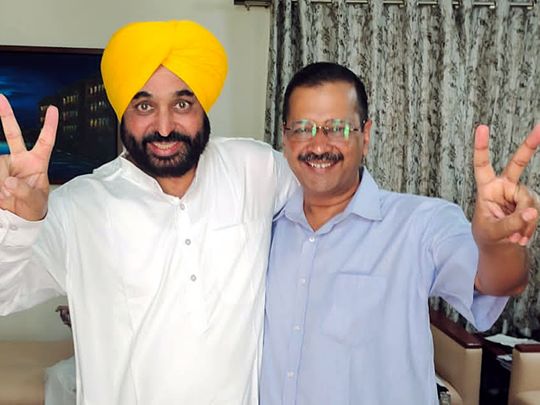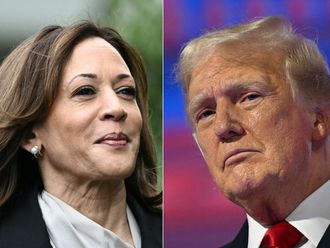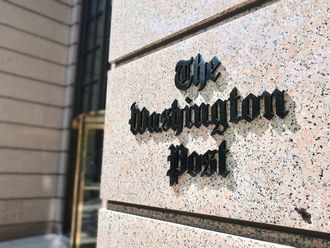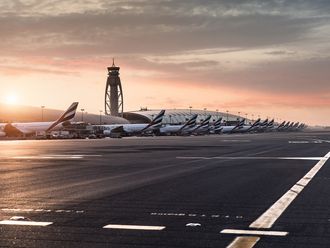
It is unfortunate that in a country of 1.38 billion, there seems to be an acute scarcity of political leaders with a pan-India appeal.
Right now, India only has a handful of political leaders who have been able to cut cross the boundaries of their respective regions.
Narendra Modi has built his leadership in the Hindi heartland with a stable power base in Gandhinagar. He was the long-time chief minister of Gujarat and also had the advantage of being from a major political party with a weatherproof nationalist ideology. Even beyond the Hindi-speaking states, his “brand-recognition” is highest among all his competitors.
Arvind Kejriwal’s Aam Aadmi Party’s (AAP) recent victory in Punjab needs to be seen in view of a national demand to fill in an India-wide leadership vacuum.
Balancing factor
Kejriwal has arrived as the ‘balancing’ factor in the current political set up in a few states. There are millions of voters who think the BJP and Congress, both, are compromised in various degrees in the states of their influence, in using a system of governance that has failed people and created urban slums, unemployment, poor health and education infrastructure etc.
Kejriwal’s biggest strength is that he arrived on the Delhi stage without any baggage. He doesn’t belong to any political dynasty, nor did he have any godfather.
Unlike Modi or Rahul Gandhi, he is the founder of his own party. At 53 and with just 10 years into power politics, his achievements are overwhelming. He twice defeated the formidable duo of Modi-Shah in a straight fight in New Delhi state election.
His party is new so like the BJP or Congress or Modi/Rahul Gandhi, he or his party isn’t tagged when one debates the Emergency, the 1984 riots or Gujarat riots of 2002 or the demolition of the Babari mosque in Ayodhya.
On all issues of national importance, Kejriwal can afford to build his own narrative — one that suits him.
A little premature
Still, it’s premature to think that Kejriwal can convert dejected voters at the national level into the AAP voters in the 2024 general elections.
He is aiming to open the account in an impressive manner so that he gets recognition as a national party by the Election Commission of India.
Kejriwal’s current success needs to be analysed without going too overboard. There are two major reasons for that.
First, Punjab is a stand-alone case where the Sikh faith and the state’s politics are closely interwoven.
This is the first time that the state, which is historically vital to the Sikh faith, was swayed by a Hanuman-Chalisa chanting Haryana-born politician. That’s an overwhelming moment for Kejriwal but this historic success is fraught with many inbuilt issues.
One must not forget the Modi’s farm laws were seen by Sikh farmers as “anti-Sikh” that would hit funding of Gurudwaras in Punjab. Some secessionist forces also worked behind the scenes to spread this perception.
Punjab will be a serious challenge to govern by anyone who is perceived as a soft-Hindu.
Since its bifurcation in 1966, which gave birth to Haryana and Punjab, this border-state has always been ruled by a Sikh — by design.
If Modi is getting less popularity rating in Punjab, it is for a reason. Sikhs, by their political nature, have been hard-core nationalists but against the rulers of New Delhi and Hindu majoritarianism.
The Akali Dal’s politics prospered for those same reasons. The fall of Akali Dal came because the Badals exploited their position, making unheard of wealth and the Akalis of all shades developed nexus with the Sikh Congress leaders to keep tight control over the all-powerful Sikh Gurudwara Prabandhak Committee (SGPC).
The space created due to the untenable socioeconomic situation gave entry to Kejriwal in 2022.
But, chief minister Bhagwant Mann is not looking strong enough to give a clear impression that he is not Kejriwal’s proxy.
It’s a tall order for CM Mann, knowing well that Kejriwal is the one man army of AAP.
Delicate situation
Talks of Hindu Rashtra by hardliner Hindu leaders affects Sikhs psyche as much as it impacts Muslims and Christians.
In such a delicate situation, when Gurudwaras in interiors of Punjab keep a close watch on claims of Hindutva assertion, Punjab’s regional politics is expected to go full throttle now as Kejriwal has opened Punjab for a non-Punjab based, Haryanvi Hindu-led party.
It’s a turning-point for Punjab. Till now BJP was playing second fiddle to Akalis — its alliance partner. Now, BJP will take on Kejriwal in Punjab. Along with it arrive serious issues like water-sharing and the dispute around Chandigarh between Punjab and Haryana.
Here, the sensitivity for Sikhism, agricultural issues, and the security of borders are priorities.
It will be a “make or break” situation for Kejriwal. Needless to say, Sikhs are very proud Indians and have come up through many struggles. It will be difficult to be “natural ally” of the Punjabi Sikhs for AAP if Sikhs don’t feel secure.
Politics of accommodation
Second, Kejriwal’s victory needs to be looked at from the point of view of national trends.
Apart from the BJP, Kejriwal will face opposition from Congress, TMC and other leaders who want to take on Modi seriously. Kejriwal’s biggest psychological road-breaker is that despite big electoral victory in the Delhi assembly, he has not been able to win even one seat in Lok Sabha from Delhi. Its clear that Indian voters vote differently in Lok Sabha and assembly elections.
In the last one-decade, Kejriwal is on “ekla chalo re” path. Maharashtra Vikas Aghadi is the example of three anti-BJP parties (Shivsena, Congress and NCP) with their big leaders displaying accommodation. Kejriwal hasn’t shown such “politics of accommodation” so far.
BJP may be jealous of Kejriwal’s rise but the ruling party hasn’t lost even a bit of their confidence because they think Kejriwal is a freelancer of Indian politics who has come up with populism, civic nationalism and economically unsustainable freebies for poor voters.
Amit Shah and many political leaders believe that all political parties should have a political ideology.
Kejriwal is walking on a tight rope in balancing communal and caste issues.
Lately, he has presented a hybrid ideological stance of his party — AAP. He asked CM Mann to keep B.R. Ambedkar and Bhagat Singh’s portrait in government offices in Punjab.
Ambedkar was architect of India’s Constitution and a Dalit messiah while Bhagat Singh was a radical and communist.
Right now, nobody knows how his secularism is different or more genuine from that of Rahul Gandhi and how his thinking on Hindu identity politics is different from the BJP. Presently he is playing all his cards by resorting to rhetoric.
Nothing wrong if that is an attempt to carve out his own ideology for development while skirting divisive issues but when his populist politics meets economic realities, chances are that the BJP and opposition parties will ensure that he is pushed to the wall.











